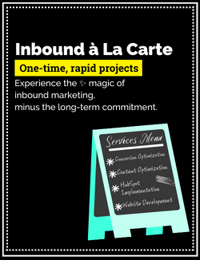%20(1)-1.jpeg?width=1180&name=AdobeStock_145045985%20(1)%20(1)-1.jpeg)
How a Visitor-First Approach Increases Conversion Rate Optimization
June 7, 2023
By Abe Schmidt
You know your brand’s website like the back of your hand, but do you know what experience your website delivers to visitors?
Your website should be one of your company’s hardest workers, from making a great first impression to actually converting customers. Using the right tools, we can put ourselves in our website visitors’ shoes to gain insights that will empower our conversion rate optimization (CRO) efforts.
How Does Conversion Rate Optimization Work?
Conversion rate optimization means achieving the best possible ratio of website visitors who take a desired action, such as making a purchase or scheduling a consultation. To accomplish this, we have to focus on optimizing the website experience.
There are many ways you can improve your website to boost conversion rates. For instance, this might involve:
- Optimizing your website for all devices: Mobile traffic accounts for more than half of all website visits.
- Making your website navigation more intuitive: Easy navigation is the most important feature a website should deliver, according to 94 percent of consumers.
- Enhancing your page design: According to web designers, a low conversion rate is the top reason to redesign a website.
- Improving site speed across platforms: Research shows improving mobile site speed by even one-tenth of a second leads to higher conversion rates, especially in the travel and retail industries.
These are just a few areas to consider among many. Everything from the placement and wording of your calls to action (CTAs) to your use of multimedia and design elements can influence your CRO.
What Does It Mean to Take a Visitor-First Approach to CRO?
Because CRO seeks to encourage website visitors to convert, it makes sense to think about the website experience from a visitor’s perspective. Fortunately, with modern tools and resources, you don’t have to guess how visitors interact with your website.
We can use research related to human behavior to design from a visitor-first perspective, resulting in a website that provides a better experience for first-time and repeat visitors alike.
Empower Your Visitor-First CRO with the Right Practical Tools
You need a baseline to learn how visitors interact with your website and find areas for improvement. One suite of tools I highly recommend for collecting that data is Lucky Orange. Lucky Orange provides insights into the user journey on your site through tools like user session recordings and dynamic heatmaps, and it can directly integrate with Hubspot and other platforms.
Step 1: Gather Data
These tools allow us to look for interactions (or a lack of interactions) that run contrary to what we want to see visitors doing on our website. For instance, we might identify:
- Unexpected page interactions that we wouldn't normally associate with the intended navigation behavior.
- Interactions that occur before bouncing without completing the purchase or contact process.
- Forms and CTAs that are being ignored.
Step 2: Make Changes
After we figure out potential problems, we come up with possible solutions and propose, build, and release the changes based on our findings. This may consist of undergoing a total website redesign or simply making a few tweaks here and there.
Step 3: Reevaluate
The next step—and one of the more important steps of the CRO process—is reevaluation. Also known as A/B testing, this is where we see what impact our changes to the website are having on visitors’ behavior and likelihood to convert. We can see this play out by watching recordings of visitors interacting with the new version of the site and viewing their heatmap data. This A/B testing phase can provide even more insights to help us refine the site in the next round of revisions.
Collect information, make changes, measure results, repeat. This is the key to a great conversion rate optimization process, and tools like Lucky Orange are an infinitely valuable ally.
Partner Up for Effective Visitor-First CRO
Conversion rate optimization can be an involved process. If you’re overwhelmed or need support, consider contracting with a partner. A do-it-yourself approach is a real miss if it keeps your website from realizing its full converting potential.
Want a helping hand to do the heavy lifting? SmartBug Media offers fixed-scope projects so you can get the help you need without making a long-term commitment. We can offer CRO guidance, a website redesign, and many other services to help you put website visitors first and reap the rewards. Learn more about Inbound à la Carte from SmartBug.
About the author
Abe Schmidt Abe Schmidt is a Senior UX Strategist at Smartbug Media. With over 15 years of experience with Marketing and SEO agencies, Abe brings a knowledgeable, unique, and modern perspective to his UX Strategies. Read more articles by Abe Schmidt.







-4.png?width=800&length=800&name=Untitled%20design%20(1)-4.png)
